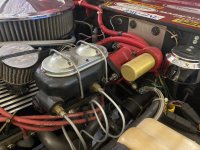My brake setup is very similar- ok, scratch that- identical as far as I know- to Todd's. Can't measure anything because it's not running and won't be for a few months. But Todd's numbers sound about right. Adding to the equipment he described, we are also running 2010-ish Dodge 1500 front brakes which actually have slightly less caliper piston area than the 70's vintage big piston Ford calipers they replaced, and Explorer rear discs. Entirely qualitative but that combination has been the magic bullet combination of brake "feel" (linearity?) and stopping power, right up to the limit of traction. I wish my new Tacoma had brakes as nice as those on my Bronco.
Agreed that in the stock location (what I have) the boost unit and master cylinder occupy a lot of space out in the middle of everywhere, but that leaves more room on my driver's inner fenderwell to bolt crap down. As with horizontal surfaces everywhere, can't have too much, and even then they fill up.
Agreed that in the stock location (what I have) the boost unit and master cylinder occupy a lot of space out in the middle of everywhere, but that leaves more room on my driver's inner fenderwell to bolt crap down. As with horizontal surfaces everywhere, can't have too much, and even then they fill up.












